Watering indoor plants can be a bit tricky. If you follow a few rules of thumb, you're doing your plants a big favor.
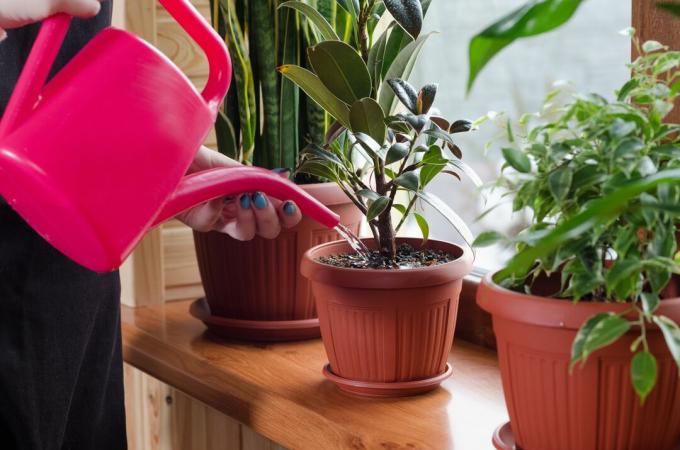
Of course, you cannot lump all houseplants with the same brush, because there are big differences in the respective water requirements. Still, there are some useful tips that will help water most houseplants properly.
contents
-
When and how often should you water indoor plants?
- Water indoor plants as needed
- Houseplant watered too much: what to do
- Which water is suitable for indoor plants?
- How to properly water indoor plants
- Automatic watering for indoor plants
When and how often should you water indoor plants?
When and how often you have to water indoor plants, of course, there is no general answer for all plants and possible circumstances. Because our indoor plants have very different requirements, which then vary depending on the planter, soil, season, humidity, plant size and temperature.
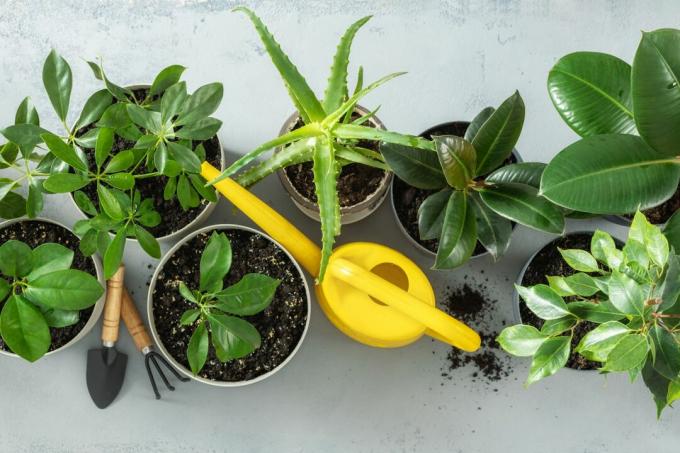
As a rule, regular but small amounts of water are more suitable for the plants than infrequent and then excessive watering of indoor plants. Signs of a clear lack of water are when the soil detaches from the edge of the pot, i.e. collapses towards the center, the plant rolls up the leaves or they hang limply. In contrast, brown spots or discoloration on the leaves in combination with a musty smell of the earth indicate an excess of water.
Watering indoor plants in summer and winter: In general, indoor plants need more watering in summer than in winter. You are then in the growth phase, there is more light and heat available and more water is evaporated. Because of the constant environmental conditions in the home, it does not matter what time of day you water.
Water indoor plants as needed
Of course, the water requirement of the plant is particularly decisive for how much has to be watered. At least the following distinction should be made:
- Low water requirement: For example Cacti and Succulents, that is, plants with thick, fleshy leaves. But also citrus plants, some herbs and plants from tropical and subtropical, arid areas can have a low water requirement. The soil does not always have to be evenly moist here, because dry phases are also survived. The substrate should even dry out a little in the meantime so that the plants stay healthy.
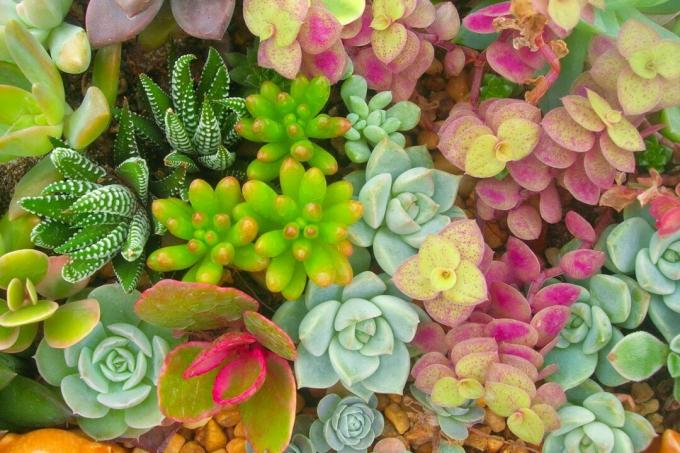
- Moderate water requirement: For example Efeutute (Epipremnum) and purple mute (Syngonium), therefore plants with many, large, rather thin leaves. They are often found in the tropics and subtropics, where they usually grow under larger plants in light shade. These need water regularly, but should not be permanently damp or even wet. Only the root ball must always be kept evenly moist. Other plants with moderate water requirements are Monstera Monkey Leaf (Monstera adansonii), Weeping fig (Ficus benjamini) and Balsam apple (Clusia).

- High water requirement: For example carnivores like the Venus flytrap (Dionaea muscipula) or marsh plants like the papyrus (Cyperus papyrus). Plants from very humid or wet areas of origin have to be watered very often or even stand in water. Also Elephant ear (Alocasia macrorrhyzos), Basket margin (Calathea), Butt thread (Aglaonema), Arrow blade (Alocasia), A leaf (Spathiphyllum wallisii) and avocado (Persea americana) have a high water requirement.
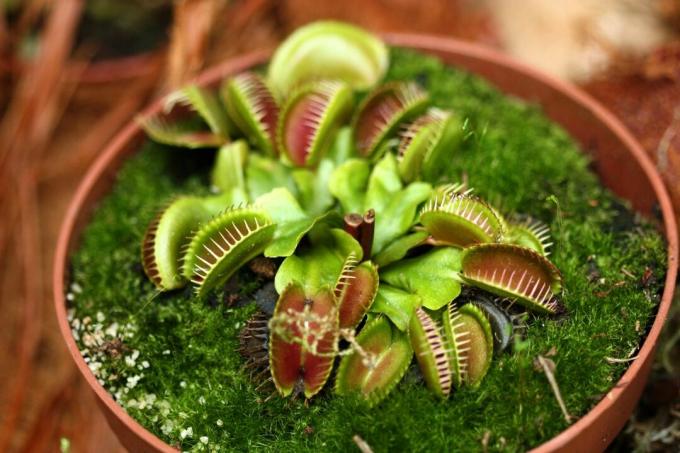
The soil is now tested with the finger test and reacts depending on the water requirement: In the case of moisture-loving plants, the substrate should never be dry, but always moist. If the surface of the earth feels dry, it is poured immediately. If the plant's water requirement is moderate, the top 2 cm of the soil can feel dry to the touch. In the case of some plants that require little water, the root ball may even dry out completely.
Tip: Plants with a high demand for water benefit in particular from a layer of mulch on the ground - as this means that less water evaporates from the substrate.
Houseplant watered too much: what to do
Sometimes you mean it too well and the houseplant accidentally got too much water. If the plant has been watered too abundantly, waterlogging and thus root rot can easily occur. Check if the soil is damp and smells musty. In this case, you have given the houseplant too much water for a long period of time. Now it is best to replace the substrate and create a drainage layer on the bottom of the pot so that the liquid can drain off better in the future.

Expert tip: Some plants should not be watered at all at certain times, namely during the resting phase. In citrus plants, for example, this phase is used to induce flowering. Also Christmas cactus (Schlumbergera x buckleyi), Desert rose (Adenium) and amaryllis (Hippeastrum) have periods of rest in which they are not or only very little poured.
Which water is suitable for indoor plants?
Most house plants prefer irrigation water with little lime. Rainwater that can be collected with a rain barrel, for example, is particularly suitable. Another option is to mix tap water and distilled water, which you can get at a hardware store. This is desalinated water that dilutes the calcium concentration in tap water. Depending on the hardness of the water, which you can find out with test strips, for example, you add more or less distilled water. Boiling or letting the tap water stand can also help if the water hardness is low.
Not only the hardness of the water, but also the particular plant is crucial for the correct mixing ratio - carnivores, for example, need water that is very low in lime.
Tip: If you pour calcareous water over a long period of time, you can see white deposits on leaves and soil. In this case, the irrigation water should be diluted or decalcified.
Methods for lowering water hardness:
- Boil or let stand
- Mix with distilled water
- Use rainwater because it is naturally softer
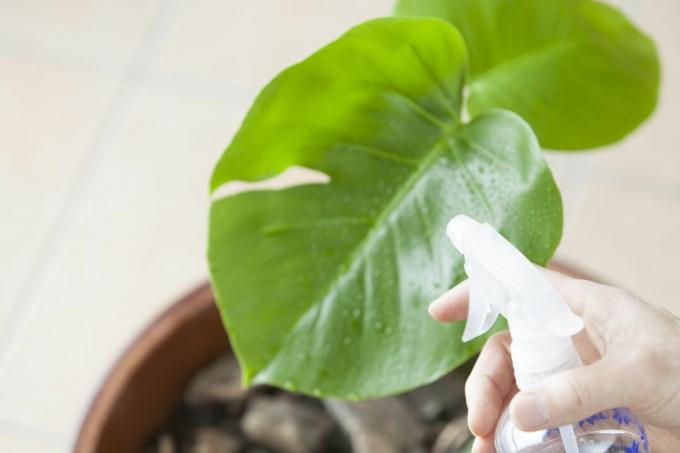
Since distilled water does not contain any minerals at all, it should not be used exclusively for watering. Due to the lack of salts in the distilled water, the plant roots cannot absorb this liquid at all. In this case, you mix in appropriate fertilizer. The addition of liquid fertilizer to the irrigation water is an important part of maintenance for almost all indoor plants during the growing season. For example, ours is suitable for many indoor plants Plantura organic indoor & green plant fertilizer terrific. It not only strengthens leaves and shoots, but also ensures vigorous root growth thanks to the microorganisms it contains. Depending on the needs of the plant, the mainly organic fertilizer is added to the irrigation water more often or less often and in appropriate doses.
Tip: The hardness of the water depends on the concentration of so-called hardness builders. These include above all calcium and magnesium. These can combine with the bicarbonates and carbonates that are always present in the water and form water-insoluble calcium and magnesium carbonates. After watering, these are dissolved again by soil acids, whereby acidifiers are consumed. As a result of the binding of these acid generators, the acid concentration in the substrate logically decreases: It becomes more basic. Most plants, however, depend on a slightly acidic, maximally neutral soil. That is why it is important to water potted plants with soft and therefore low-carbon water.
Summary:
- Almost all houseplants need a weakly acidic substrate for good growth.
- Some plants need particularly soft, i.e. low-lime, water. These include bog plants, for example the Pitcher plant (Nepenthes) or the sundew (Drosera), and plants from rainforests such as Orchids (Orchidaceae).
- Cacti and succulents, on the other hand, prefer calcareous substrate and hard water. These include popular houseplants like the Bow hemp (Sansevieria) and the Cyclamen (Cyclamen persicum).
- Some house plants like for example Zebra herb (Tradescantia zebrina), Angel trumpet (Brugmansia), Green lily (Chlorophytum comosum) or Efeutute (Epipremnum) are very tolerant of irrigation water. They can also tolerate lime-rich water as long as they are planted in suitable, weakly acidic soil.

How to properly water indoor plants
This question cannot be answered in the same way for all indoor plants. Basically, plants should not be watered from above on the leaves. As a result, the irrigation water often does not reach the substrate and evaporates directly from the green. But even here there are exceptions. Bromeliads are poured directly into their funnel-shaped leaves, for example. However, many indoor plants, especially those that come from the tropics, like a high level of humidity, which is achieved by spraying the leaves. However, this should be a separate part of the maintenance.
After watering, wait about fifteen minutes before pouring off the excess water that has collected in the saucer. Most plants do not tolerate waterlogging well.

Alternatively, houseplants can also be watered from the very bottom. That means, you put the water in the coaster, wait about 15-20 minutes and then pour off the remaining liquid. The plant and substrate suck the water out of the saucer as needed. This watering method is particularly suitable for plants with sensitive and dense foliage such as bobbed heads. Since nutrient salts are not washed down by the irrigation water with this method, white deposits can occur on the substrate surface.
Another option, which is particularly useful when the substrate is dried out, is to immerse indoor plants. Here you put the plant and its inner pot in a bucket with water and wait until no more bubbles rise. Lift the houseplant out again and let the soil drain well.

Automatic watering for indoor plants
Whether on vacation or in everyday life - automatic irrigation is sometimes helpful for indoor plants. Various methods are available for this:
- Bottle irrigation: Bottles are filled with water, the lids are pierced with small holes and the whole thing is put upside down in the ground. This allows the water to gradually flow into the substrate.
- Thread irrigation: A bucket of water is placed next to the plants to be watered. Long pieces of fabric or threads are hung on one side in the vessel and weighed down, the other side goes into the ground. This is how the water is transported from the bucket to the plant.
- Bathtub irrigation: You can also put wet towels in the bathtub and place the plants on them without a cachepot.
The problem with such systems is that the water requirements of the individual plants cannot be taken into account. They are therefore not suitable for crops that require little water. In our special article on Plant watering on vacation you will find additional methods and helpful tips.
Houseplants don't just have to be watered, they also need regular nutrients. We'll show you what the Fertilizing indoor plants must be observed.
